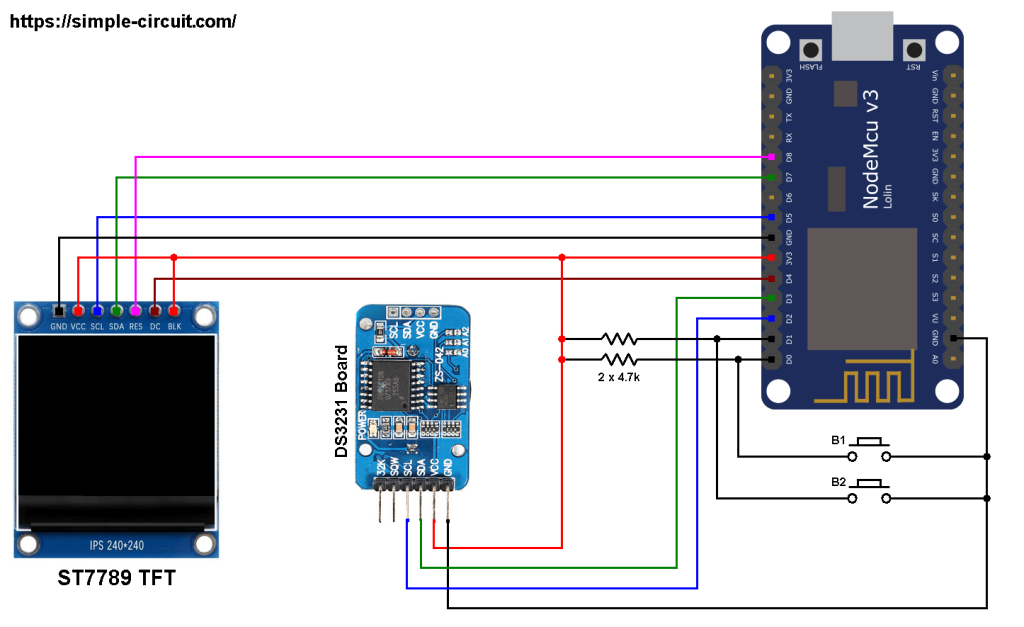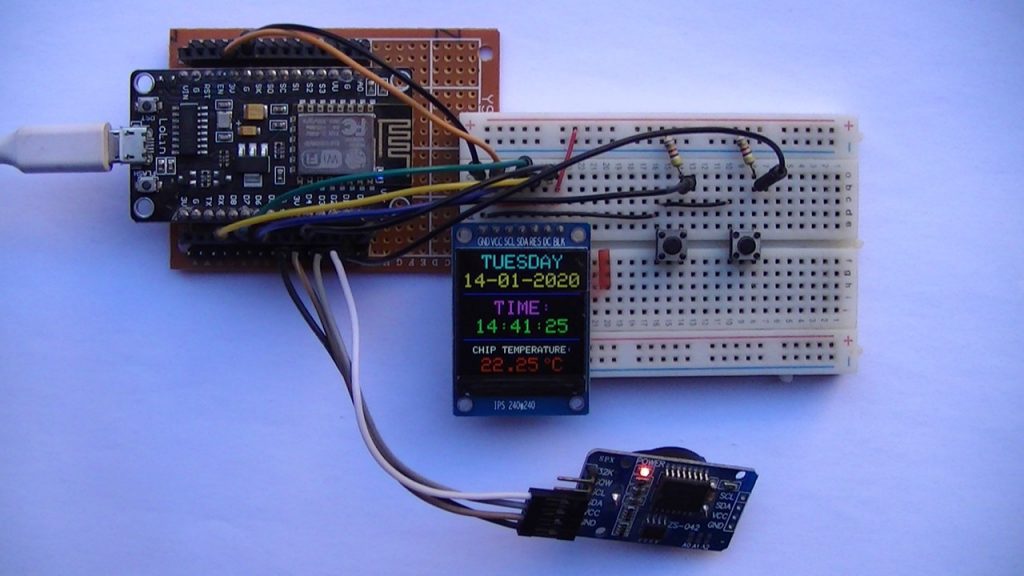This tutorial shows how to make a digital real time clock using ESP8266 NodeMCU board (ESP-12E) and DS3231 RTC module where time & date can be set with two push buttons connected to the NodeMCU and they are printed (with RTC chip temperature) on ST7789 TFT display.
The ST7789 TFT module contains a display controller with the same name: ST7789. It’s a color display that uses SPI interface protocol and requires 3, 4 or 5 control pins, it’s low cost and easy to use. This display is an IPS display, it comes in different sizes (1.3″, 1.54″ …) but all of them should have the same resolution of 240×240 pixel, this means it has 57600 pixels. This module works with 3.3V only and it does not support 5V.
TFT: Thin-Film Transistor.
SPI: Serial Peripheral Interface.
IPS: In-Plane Switching.
IIC (or I2C): Inter-Integrated Circuit.
Hardware Required:
- ESP8266 NodeMCU board
- ST7789 TFT display module
- DS3231 module —-> DS3231 Datasheet
- 2 x push button
- 2 x 4.7k ohm resistor
- 3V coin cell battery
- Micro USB cable (for programming and powering the whole circuit)
- Breadboard
- Jumper wires
ESP8266 NodeMCU with ST7789 TFT and DS3231 RTC circuit:
The image below shows project circuit schematic diagram.
The ST7789 Display Module shown in project circuit diagram has 7 pins: (from right to left): GND (ground), VCC, SCL (serial clock), SDA (serial data), RES (reset), DC (or D/C: data/command) and BLK (back light).
Connecting the BLK pin is optional. The back light turns off when the BLK pin connected to the ground (GND).

The ST7789 TFT Display Module is connected to the NodeMCU board as follows:
GND is connected to pin GND of the NodeMCU board,
VCC and BL are connected to pin 3V3,
SCL pin is connected to D5 (ESP8266EX GPIO14),
SDA pin is connected to D7 (ESP8266EX GPIO13),
RES pin is connected to D8 (ESP8266EX GPIO15),
DC pin is connected to D4 (ESP8266EX GPIO2).
If the display module has a CS pin (Chip Select) then it should be connected directly to NodeMCU GND pin.
Pins D5 (GPIO14) and D7 (GPIO13) are hardware SPI module pins of the ESP8266EX microcontroller respectively for SCK (serial clock) and MOSI (master-out slave-in).
The DS3231 RTC Module SCL (serial clock) and SDA (serial data) pins are respectively connected to NodeMCU pins D2 (GPIO4) and D1 (GPIO0).
The two push buttons which are connected to NodeMCU pins D0 (GPIO16) and D1 (GPIO5) are for setting time & date.
ESP8266 NodeMCU with ST7789 TFT and DS3231 RTC code:
The following Arduino code requires 3 libraries from Adafruit Industries:
The first library is a driver for the ST7789 TFT display which can be installed from Arduino IDE library manager (Sketch —> Include Library —> Manage Libraries …, in the search box write “st7789” and install the one from Adafruit).
The second library is Adafruit graphics library which can be installed also from Arduino IDE library manager.
The 3rd library is for the DS3231 RTC, it may be installed using library manager (in the search box write “rtclib” and choose the one from Adafruit).
The 3 libraries can be installed manually, first download them from the following 3 links:
Adafruit ST7789 TFT Library —-> Direct Link
Adafruit Graphics Library —-> Direct Link
Adafruit RTC Library —-> Direct Link
After the download, go to Arduino IDE —> Sketch —> Include Library —> Add .ZIP Library … and browse for the .zip file (previously downloaded).
The same thing for other library files.
Hints:
The 3 libraries are included ( & Arduino Wire library) in the main code as follows:C
| #include <Wire.h> // Wire library (required for I2C devices) #include <Adafruit_GFX.h> // Core graphics library #include <Adafruit_ST7789.h> // Hardware-specific library for ST7789 #include “RTClib.h” // RTC library |
The connection of ST7789 TFT display with the NodeMCU is as shown below where the display is connected to hardware SPI module of the NodeMCU (pins: SCK and MOSI):C
| // ST7789 TFT module connections #define TFT_RST D8 // TFT RST pin is connected to NodeMCU pin D8 (GPIO15) #define TFT_DC D4 // TFT DC pin is connected to NodeMCU pin D4 (GPIO2) #define TFT_CS -1 // TFT CS pin is directly connected to GND // initialize ST7789 TFT library with hardware SPI module // SCK (CLK) —> NodeMCU pin D5 (GPIO14) // MOSI(DIN) —> NodeMCU pin D7 (GPIO13) Adafruit_ST7789 tft = Adafruit_ST7789(TFT_CS, TFT_DC, TFT_RST); |
And the TFT display is initialized using the following command:C
| // if the display has CS pin try with SPI_MODE0 tft.init(240, 240, SPI_MODE2); // init ST7789 display 240×240 pixel |
The two push buttons are defined in the code as:C
| const int button1 = D0; // button B1 is connected to NodeMCU D0 (GPIO16) const int button2 = D1; // button B2 is connected to NodeMCU D1 (GPIO5) |
Functions Used In The Code:
bool debounce (): this function is for button B1 debounce, returns 1 if button is debounced.
void RTC_display(): displays day of the week, date and time on the display.
byte edit(byte parameter): this function is for setting the real time clock, returns the edited parameter.
Rest of code is described through comments.
Full Arduino Code:

